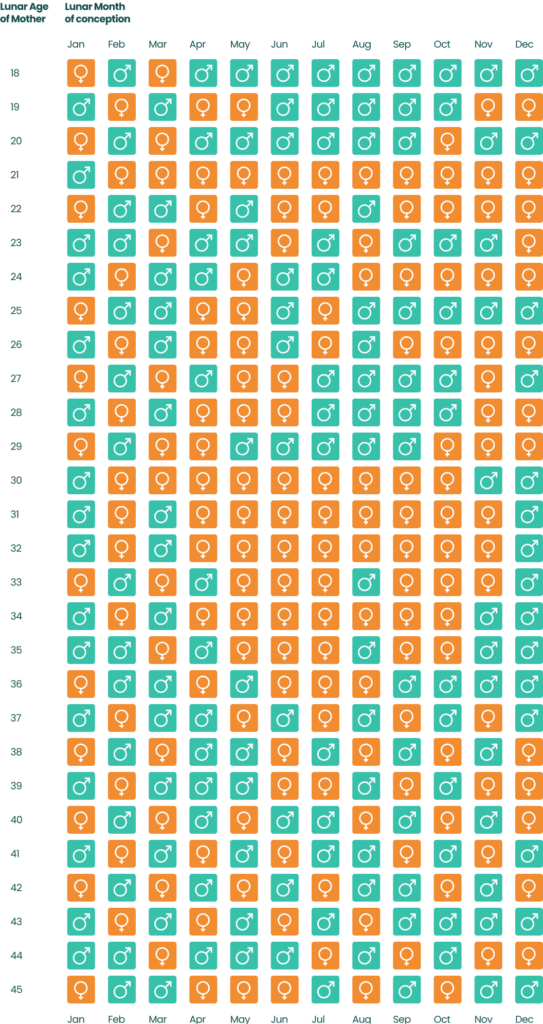Chinese Gender Predictor: Quick Tool For New Parents In 2024

Input Your Information Below
How To Use The Chinese Baby Predictor?
- Input the mother’s date of birth and the date of conception.
- The information is translated into the traditional lunar calendar. Then, a historical chart cross-references the inputs to predict a baby’s sex.
- The predictor is a non-scientific method, focusing more on connecting with culture and history.
Like many parents, you might be extremely curious about your new baby’s gender. While pondering over whether or not it’s a boy or girl, you might consider trying the Chinese Gender Predictor.
This tool has intrigued parents worldwide, offering a fun and interesting way to predict a baby’s gender. With roots in ancient Chinese astrology and royal birth planning, this predictor is rich in history. It claims to forecast whether you’ll have a boy or girl based on the lunar calendar.
This tool isn’t just about guessing; it’s a way to connect with a tradition that has made its way through dynasties to smartphones.
Learn its origins, how it works, its reliability, and other options to consider. If you’d also like to dive deeper into prenatal health, check out these prenatal reviews for more detailed information.
How Does The Chinese Gender Predictor Work?

The Chinese Gender Predictor is a tool that uses cultural traditions to estimate genders. It references the mother’s lunar age with the lunar month of conception.
The lunar calendar is said to come from the Xia and Shang Dynasties, from as far back as the 11th century BCE. It’s based on astronomy and geography, diving the year into agricultural seasons and traditional festivals. It’s rooted in a belief system that aligns human dynamics with cosmic rhythms.
Input Data (The Information Readers Need To Provide)
There are only two pieces of information needed to use the Chinese Gender Predictor:
- The mother’s birth date.
- Date of conception.
Output Data (The Results Readers Will Get From The Tool)
Once you enter your information, the predictor will automatically predict your baby’s gender.
How Does This Tool Work? (Following The Formulas, Charts, Studies, Etc.)
The Chinese Gender Predictor uses a chart that cross-references the mother’s lunar age with the lunar month of conception. The Chinese birth chart is claimed to be based on an ancient artifact, applying astrology and the Chinese lunar calendar to forecast the baby’s sex.
The Chinese gender birth chart itself was claimed to have been found in the tomb of an emperor in the last century. This is because the sex of the children of ancient Chinese emperors was extremely important at that time.
Chinese Gender Calendar
The Chinese gender calendar is central to the predictor’s functioning. It converts solar dates to lunar ones to align with the ancient Chinese gender chart.
The conversion to lunar dates is crucial since it aligns with the energies and cycles the ancient Chinese believed influenced life’s outcomes. The Chinese gender calendar doesn’t just check time, but a cycle of energy that, according to lore, can influence future outcomes.
Is The Chinese Gender Predictor Accurate?
The Chinese Gender Predictor works more so considered a guessworking tool, rich in tradition, rather than a scientifically validated tool. It doesn’t have many scientific studies available to test its accuracy. In fact, a recent 2023 study concluded that it’s not a reliable method for determining sex.
Overall, this calculator operates on a historical and cultural framework and naturally is not based on contemporary understandings. Now, we have advanced medical procedures that can offer a 100% accuracy rate for gender.
The lack of studies proving its accuracy means that it’s best viewed as a speculative tool, not a definitive one. However, it remains a popular tool for expectant parents. Its appeal isn’t necessarily in accuracy, but in the cultural significance and engagement it brings to the pregnancy experience.
This predictor serves as a link to the past, allowing families to uphold traditions that have been cherished for generations. For those who would like the certainty of knowing the sex of their baby, a medical test is recommended.
Benefits Of The Chinese Gender Predictor
Here are some of the potential benefits of using the Chinese pregnancy predictor tool:
- Cultural Engagement: As this tool is rich in tradition for many with Chinese roots, using it can be a fun way to feel a part of the culture. It’s a way to engage with a piece of cultural history that’s been passed down through generations. This can provide a strong sense of community and participation, which is also beneficial for mental health and bonding.
- Bonding Experience: Sharing the results of the predictor with family and friends can be a fun bonding experience. It might open up interesting conversations and create an environment to speak about concerns and expectations for the new parents. Making predictions and betting on who’s right can just be a fun way to spend time with those you love.
- Fun And Anticipation: The excitement of not knowing and guessing a baby’s gender can add an element of fun anticipation to the pregnancy journey. It can be a harmless way to imagine your new life and share dreams with friends.
- Personal Insight And Reflection: As you use the predictor or see its results, you might gain insight as to your expectations. It may also help you reflect on what life could be like with that sex, and help you to imagine planning a particular future.
- Planning And Preparation: Some parents take the predictor more seriously and may use it to start preparing and personalizing their baby’s welcome to the world. They may begin imagining names, decorating the nursery, or selecting clothes to make the waiting period more engaging.
- Alternative To Modern Technology: For parents who don’t want to officially know the sex of their baby through medical methods, this can be a fun way to help people move forward. The predictor is free, easy to access, and can spur the planning and preparation more seriously.
This Asian gender calendar serves as a unique bridge between past and present, offering cultural engagement for parents.
How To Find Out Baby’s Gender For Sure
If you’d like to find out your baby’s gender for certain, several medical processes can be used at specific stages of pregnancy. These include:
Ultrasound Scans
It’s common to do an ultrasound scan around week 18 to 22 of pregnancy. This scan is non-invasive, using sound waves to create images of the baby in the womb. The sonographer can then identify male or female genitalia.
Its accuracy depends on factors like the baby’s position, the week, sex, the equipment used, and the sonographer. Studies show 100% accuracy for predictions made after 14 weeks of gestation. While it’s possible to do the scan earlier, a gestational age of 11-14 weeks lowers accuracy.
Blood Tests
Non-invasive prenatal testing, NIPT, can be done as early as 7 weeks into the pregnancy with high accuracy. This blood test screens for chromosomal conditions and can also determine the baby’s gender. It detects the presence of Y chromosomes, which indicates a baby boy. A baby girl, on the other, would be entirely X chromosomes.
For the early stages of pregnancy, NIPT can determine sex more accurately than ultrasounds.
Amniocentesis and Chorionic Villus Sampling
These tests are more invasive and usually reserved to screen genetic disorders. It can accurately determine gender, but the other options are safer. The baby’s development can be harmed by this procedure.
Amniocentesis is usually done between weeks 15-20 of pregnancy. Chronic Villus Sampling, or CVS, is around weeks 10 to 13. Due to risks including pregnancy loss, they’re not recommended unless there is a risk of a genetic condition.
Final Thoughts
After diving into the research, it’s clear that the Chinese Gender Predictor is less about pinpoint accuracy and more about traditional engagement. It allows expectant parents to take part in an ancient tradition going back hundreds of years. Families can come together and share stories, and guesses, and enjoy bonding time over the results.
While it’s not a scientifically accurate tool, it can still be a fun, culturally enriching, and engaging tool. The Chinese gender determination chart uses ancient history and the lunar calendar to determine birth gender.
For those interested in 100% accuracy, it’s best to look toward non-invasive medical procedures. The most common is an ultrasound between 18 to 22 weeks of pregnancy.
If you can’t wait to find out, a blood test can be done as early as 7 weeks to find out the gender of your baby. These are still highly accurate and can help expectant parents plan their future pregnancy better.
In the end, this calculator is a blend of past and present, allowing parents and families to partake in important cultural traditions.
Frequently Asked Questions
You can get an ultrasound to determine your baby’s sex around weeks 18 to 22 of pregnancy. Otherwise, non-invasive prenatal testing, NIPT, is a blood test that can be done as early as 7 weeks.
You can use the Chinese Gender Predictor at any point during your pregnancy. It’s an estimate based on the mother’s lunar age at conception and the lunar month of conception.
Using the Chinese calendar to find gender is entirely up to you. This Asian gender calendar can be a fun and engaging way to guess, but it’s not scientifically proven. It doesn’t replace medical methods to determine a baby’s sex.
+ 11 Sources
Health Canal avoids using tertiary references. We have strict sourcing guidelines and rely on peer-reviewed studies, academic researches from medical associations and institutions. To ensure the accuracy of articles in Health Canal, you can read more about the editorial process here
- Huang, Y.-S., Chiu, J., Lin, C.-Y. and Robin (2022). The effect of Chinese lunar calendar on individual investors’ trading. Pacific-basin finance journal, [online] 71, pp.101694–101694. doi:https://doi.org/10.1016/j.pacfin.2021.101694.
- Aprofema s.r.o (2023). Predicting Baby Gender Using the Chinese Lunar Calendar | Actual Gynecology And Obstetrics. [online] Actualgyn.com. Available at: https://www.actualgyn.com/en/article/2023/281 [Accessed 22 Apr. 2024].
- Kearin, M., Pollard, K. and Garbett, I. (2014). Accuracy of sonographic fetal gender determination: predictions made by sonographers during routine obstetric ultrasound scans. Australasian journal of ultrasound in medicine, [online] 17(3), pp.125–130. doi:https://doi.org/10.1002/j.2205-0140.2014.tb00028.x.
- Aman Deep Raj, Roshni Abichandani and Sethi, H. (2021). Relationship of lunar phases and sex of the foetus: a retrospective study. International journal of reproduction, contraception, obstetrics and gynecology, [online] 10(8), pp.3023–3023. doi:https://doi.org/10.18203/2320-1770.ijrcog20212948.
- National Institute of Biomedical Imaging and Bioengineering. (2023). Ultrasound. [online] Available at: https://www.nibib.nih.gov/science-education/science-topics/ultrasound [Accessed 22 Apr. 2024].
- Bowman-Smart, H., Savulescu, J., Gyngell, C., Mand, C. and Delatycki, M.B. (2019). Sex selection and non‐invasive prenatal testing: A review of current practices, evidence, and ethical issues. Prenatal diagnosis, [online] 40(4), pp.398–407. doi:https://doi.org/10.1002/pd.5555.
- Kearin, M., Pollard, K. and Garbett, I. (2014). Accuracy of sonographic fetal gender determination: predictions made by sonographers during routine obstetric ultrasound scans. Australasian journal of ultrasound in medicine, [online] 17(3), pp.125–130. doi:https://doi.org/10.1002/j.2205-0140.2014.tb00028.x.
- Medlineplus.gov. (2015). What is noninvasive prenatal testing (NIPT) and what disorders can it screen for?: MedlinePlus Genetics. [online] Available at: https://medlineplus.gov/genetics/understanding/testing/nipt/ [Accessed 22 Apr. 2024].
- Ormstad SS;Stoinska‐Schneider A;Solberg B;Fure B;Juvet LK (2016). Non‐Invasive Prenatal Testing (NIPT) for Fetal Sex Determination. Health Technology Assessment [Internet]. [online] Available at: https://pubmed.ncbi.nlm.nih.gov/29553638/ [Accessed 22 Apr. 2024].
- Bowman-Smart, H., Savulescu, J., Gyngell, C., Mand, C. and Delatycki, M.B. (2019). Sex selection and non‐invasive prenatal testing: A review of current practices, evidence, and ethical issues. Prenatal diagnosis, [online] 40(4), pp.398–407. doi:https://doi.org/10.1002/pd.5555.
- Zarko Alfirevic, Navaratnam, K. and Faris Mujezinovic (2017). Amniocentesis and chorionic villus sampling for prenatal diagnosis. Cochrane library, [online] 2017(9). doi:https://doi.org/10.1002/14651858.cd003252.pub2.





